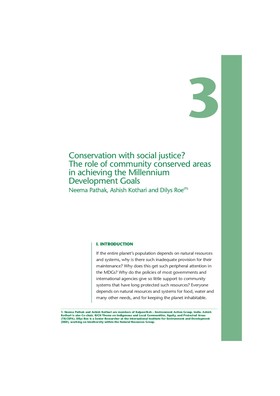MDG3-ch3.qxd 31/8/05 9:45 am Page 55 55 3 Conservation with social justice? The role of community conserved areas in achieving the Millennium Development Goals
Document begins: MDG3-ch3.qxd 31/8/05 9:45 am Page 55 55 3 Conservation with social justice? The role of community conserved areas in achieving the Millennium Development Goals Neema Pathak, Ashish Kothari and Dilys Roe(1) I. INTRODUCTION If the entire planet's population depends on natural resources and systems, why is there such inadequate provision for their maintenance? Why does this get such peripheral attention in the MDGs? Why do the policies of most governments and international agencies give so little support to community systems that have long protected such resources? Everyone depends on natural resources and systems for food, water and many other needs, and for keeping the planet inhabitable. 1. Neema Pathak and Ashish Kothari are members of Kalpavriksh Environment Action Group, India. Ashish Kothari is also Co-chair, IUCN Theme on Indigenous and Local Communities, Equity, and Protected Areas (TILCEPA). Dilys Roe is a Senior Researcher at the International Institute for Environment and Development (IIED), working on biodiversity within the Natural Resources Group. MDG3-ch3.qxd 31/8/05 9:45 am Page 56 56 More than half of the world's population depends directly on natural resources for part or all of their livelihoods and this includes a high proportion of the poorest groups. Such ...
Cite this publication
Available at https://www.iied.org/g00461
